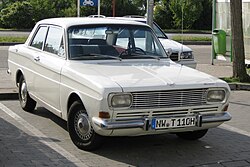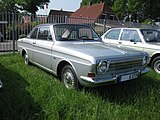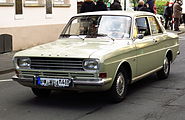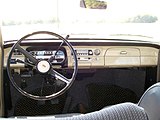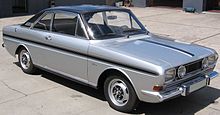Ford P6
| ford | |
|---|---|
|
Ford Taunus 15M (1966-1967)
|
|
| 12M / 15M (P6) | |
| Production period: | 09 / 1966-08 / 1970 |
| Class : | Middle class |
| Body versions : | Sedan , station wagon , coupé |
| Engines: |
Petrol engines : 1.2–1.7 liters (33–55 kW) |
| Length: | 4389 mm |
| Width: | 1603 mm |
| Height: | 1385-1425 mm |
| Wheelbase : | 2527 mm |
| Empty weight : | 845-925 kg |
| Previous model | Taunus 12M (P4) |
| successor | Ford Taunus TC |
The Taunus 12M / 15M models (from summer 1967 without the addition “Taunus”) of the P6 series (= Project 6, that is, the sixth new car construction of the Ford factory in Cologne since the end of the Second World War) are the successors to the 12m of the P4 series , from which they took over the basic design with V4 engine and front-wheel drive. With the same wheelbase, the body was a little longer, wider and flatter. The front axle was new: instead of double wishbones with wheel-guiding leaf springs, there were now MacPherson struts , triangular wishbones and rack and pinion steering. At the rear there was a rigid axle on leaf springs. The "M" in the name means "masterpiece".
After the end of production of the Ford P6, the next front-wheel drive Ford to exist in Germany was the Ford Fiesta, introduced in mid-1976 . In South America, the Ford Corcel, derived from the Renault 12 , appeared at the end of 1968 with front-wheel drive .
Model history
General
The first series ran off the tapes from September 1966 to August 1967. For the second series from September 1967 (model year 1968) some technical changes / improvements were made, including the electrical system changed to 12 volts and the interior and dashboard revised. Furthermore, from September 1967, as with the larger P7 series , the addition of “Taunus” in the name was dispensed with and the cars were only offered as Ford 12m / 15m. The third series from September 1968 was then modified / upgraded again in the equipment and replaced by the Ford Taunus TC in September 1970.
The 12M and 15M differed, among other things, in a different grille, headlights (round on the 12M, rectangular on the 15M), taillights (teardrop shape on the 12M, rectangular shape on the 15M) and they were also equipped differently in the interior. The 15m, for example, had additional fan nozzles in the dashboard.
The model name no longer said anything about the displacement, so that, for example, the 12M was also available with a 1.7 liter engine. The type designation no longer necessarily allowed conclusions to be drawn about the engine.
There were two- and four-door sedans, a three-door station wagon “Tournament”, a three-door panel van (only 12M) and a two-door coupé. The RS models offered for the first time were the ancestors of Ford's still existing "Formula RS".
From September 1966 to August 1970 around 670,000 cars (including approx. 385,000 12m and approx. 285,000 15m) were produced in three series at Ford in Cologne and Genk (Belgium). The P6 is the only P-model (P2 to P7) from Ford, of which there was no convertible conversion. The redesigned successor Ford Taunus TC ("Knudsen-Taunus") with inline engine and rear-wheel drive had the same platform as the British Ford Cortina .
15M RS (1968-1970)
The top version was the 15M RS (= Rallye Sport) presented at the Geneva Motor Show in autumn 1967 , which, like other RS or SR vehicles of that time, is a coveted classic car , especially as a coupé .
The 15M RS models were offered from March 1968 as a two- or four-door sedan and as a coupé exclusively with center shift. The second RS series followed in September 1968.
The two series differed u. a. in the number of round instruments in the dashboard (1st series = 2 instruments, 2nd series = 3 instruments) and in the steering wheel (1st series = steering wheel with three perforated spokes and a small, unpadded hub, 2nd series = covered three-spoke steering wheel with a large Impact pot). Both RS versions had a large rev counter, 4 small additional round instruments in the center console, 2 additional halogen headlights in the radiator grille and were among other things. Available with Recaro reclining seats, chromed (instead of painted) steel wheels or a steel cranked roof.
The RS models of the first series were only delivered in silver-gray metallic or red and had, as a rule, the "rallye paintwork" typical of the time with black stripes running around the beading of the side flanks and between those of the bonnet. The vehicles of the second RS series were available in eight other solid and metallic colors. In the case of silver or red vehicles of the 2nd RS series, in addition to the RS interior fittings, which were already completely black, the roof lining was also black. All RS models had a 1.7-liter engine as standard, initially with 70 hp (51 kW) and brake booster as an option - from September 1968, 75 hp (55 kW) and the brake booster as standard.
Engines
The V4 petrol engines were available in different versions:
- 1.2 liter 45 hp (LC or N engine - 1967 to 1968)
- 1.3 liter 50 hp (LC or N engine)
- 1.3 liter 53 hp (HC or S engine - 1967 to 1968)
- 1.5 liter 55 HP (LC or N engine)
- 1.5 liter 65 hp (HC or S engine)
- 1.7 liter 70 hp (HC or S engine - from September 1968: 75 hp)
"LC" stood for Low Compression (low compression and regular petrol), "HC" for High Compression (high compression and premium petrol).
Technical specifications
| model | 12M | 12M 12M (1300) |
12M (1300 S) | 12M (1500) 15M 15M XL |
15M (1500 S) 15M TS 12M (1500 S) |
15M TS (1700 S) 15M RS |
12M (1700 S) 15M (1700 S) 15M XL (1700 S) 15M RS |
|---|---|---|---|---|---|---|---|
| engine | 4-cylinder four-stroke V-engine, OHV , triple bearing crankshaft, balance shaft camshaft with spur gear drive |
||||||
| designation | P6 / 2 (LC) | P6 / 3L (LC) | P6 / 3H (HC) | P6 / 5L (LC) | P6 / 5H (HC) | P6 / 7H (HC) | P6 / 7S (HC) |
| Cubic capacity in cm³ | 1183 | 1305 | 1498 | 1699 | |||
| Bore × stroke in mm | 80 x 58.86 | 84 x 58.86 | 90 x 58.86 | 90 x 66.8 | |||
| Compression: | 8.2: 1 | 8.2: 1 | 9: 1 | 8: 1 | 9: 1 | 9: 1 | 9: 1 |
| PS at 1 / min | 45/5000 | 50/5000 | 53/5000 | 55/5000 | 65/5000 | 70/5000 | 75/5100 |
| Maximum torque at 1 / min | 80 Nm at 2400 | 93 Nm at 2500 | 96 Nm at 2400 | 105 Nm at 2500 | 115 Nm at 2500 | 134 Nm at 2400 | 128 Nm at 2500 |
| Engine code | 2 | 3 | - | L5 | 5 | 8th | 8th |
| Carburetor | Solex 28 PDSIT-4; from 9/68: Ford C8GH-A | Solex 32 PDSIT-4; from 9/68: Ford C8GH-A | Solex 32 PDSIT-4 | Solex 32 TDID - register carburetor | |||
| Valve control: | from central camshaft to tappets , bumpers and rocker arms | ||||||
| cooling | Water cooling with pump, thermostat and fan | ||||||
| transmission | fully synchronized 4-speed gearbox | ||||||
| Final drive translation | 1.2 ltr. = 4.125: 1; 1.5 ltr. LC / HC and 1.7 ltr. HC = 3.50: 1; all others = 3.78: 1 | ||||||
| circuit | Steering wheel shift; on request from 2/68: middle gearshift (standard in RS) | ||||||
| Power transmission | Front wheel drive; Engine in front of the front axle; Drive shafts with universal joints and sliding pieces or from 9/68 with Löbro constant velocity joints (not 1.3 LC) | ||||||
| body | Self-supporting all-steel body, welded to the floor pan; front fenders bolted | ||||||
| steering | Rack and pinion steering;
Gear ratio 19: 1; Turning circle 11m; 3 different steering wheel types in 3 series |
||||||
| Front axle | Independent suspension on
Wishbones and MacPherson struts |
||||||
| Rear axle | rigid pipe axis
Semi-elliptic longitudinal leaf springs; Telescopic shock absorbers |
||||||
| Brakes | Single circuit or from 9/67 dual circuit brake system; Front disc brakes, rear drum brakes; On request from 2/68: brake booster (standard in the 1.7 HC, from 9/68 also in the 1.5 HC) | ||||||
| Tires / rims | 5.60-13 or 5.90-13 (only tournament / panel van and 1.7 HC) on 4J x 13 rims (3-hole or 5-hole for tournament / panel van) or on 4.5J x 14- (5-hole) rims (on request from 9/68 or as standard for 1.7 HC tournament / panel van or 155 SR 14 on 4.5J x 14 (5-hole) sports rims (only 15m RS)) | ||||||
| Length × width × height in mm | 4389 × 1603 × 1400 (sedan); 4389 × 1603 × 1385 (coupe); 4389 × 1603 × 1425 (tournament / van) | ||||||
| Electrical system: | up to 8/67: 6 volts, DC alternator with charge regulator, from 9/67: 12-volt system from 9/66 on request: 12-volt system with three-phase alternator |
||||||
| Wheelbase in mm | 2527 | ||||||
| Track width v / h in mm | 1321 | ||||||
| Empty weight in kg | 12M: 850 / 15M: 865 (Lim., Two-door; TS / XL / RS each +5); 12M: 870 / 15m: 885 (Lim., Four-door .; TS / XL / RS each +5); 12M: 845 / 15M: 865 (Coupé; TS / XL / RS each +5); 12M: 910 / 15M: 925 (tournament); 12M: 885 (panel van) | ||||||
| Luggage / load space in liters | 560/1000 or with the rear bench seat folded down in the tournament 1700; around 1850 in a van | ||||||
| Maximum speed in km / h | 125 | 130 | 135 | 135 | 145 | 155 | 160 |
| Consumption per 100 km in liters | 7.8 | 7.8 | 8.0 (super) | 8.0 | 8.2 (super) | 8.3 (super) | 8.3 (super) |
| tank | standing on the right in the trunk or hold; Refueling from the right | ||||||
| Tank capacity in liters | 38; from 9/67 for sedan and coupé: 45 | ||||||
| Construction period | 09 / 1967-08 / 1968 | 09 / 1966-08 / 1970 | 09 / 1967-08 / 1968 | 12M / 15M: 09 / 66-08 / 70 15M XL: 09 / 68-08 / 70 |
15M TS: 08 / 66-08 / 68 15M / 15M XL: 09 / 68-08 / 70 |
15M TS: 09 / 67-08 / 68 15M RS: 1968 |
09 / 1968-08 / 1970 |
| Remarks | Cooling system with expansion tank: only series 1 (9 / 66–8 / 67); Broadband speedometer up to 8/68 (RS up to 8/68: 2 round instruments; two-spoke steering wheel without upholstery: up to 8/67; two-spoke steering wheel with upholstery: up to 8/68; three-spoke safety steering wheel with impact absorber: from 9/68); 15M RS on request with 1.5 HC / 65 HP; Special series with white, two-door basic models and higher quality equipment (only 2/68 and 2/70) | ||||||
Web links
- Ford M models 1952–1972
- Private 15M page
- http://www.ford-archiv.de:/ Advertising brochure "A first choice among the improved Ford 12M". PDF

